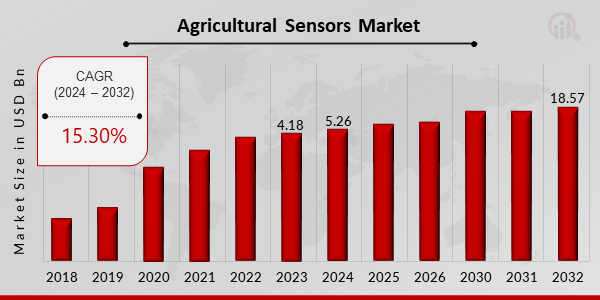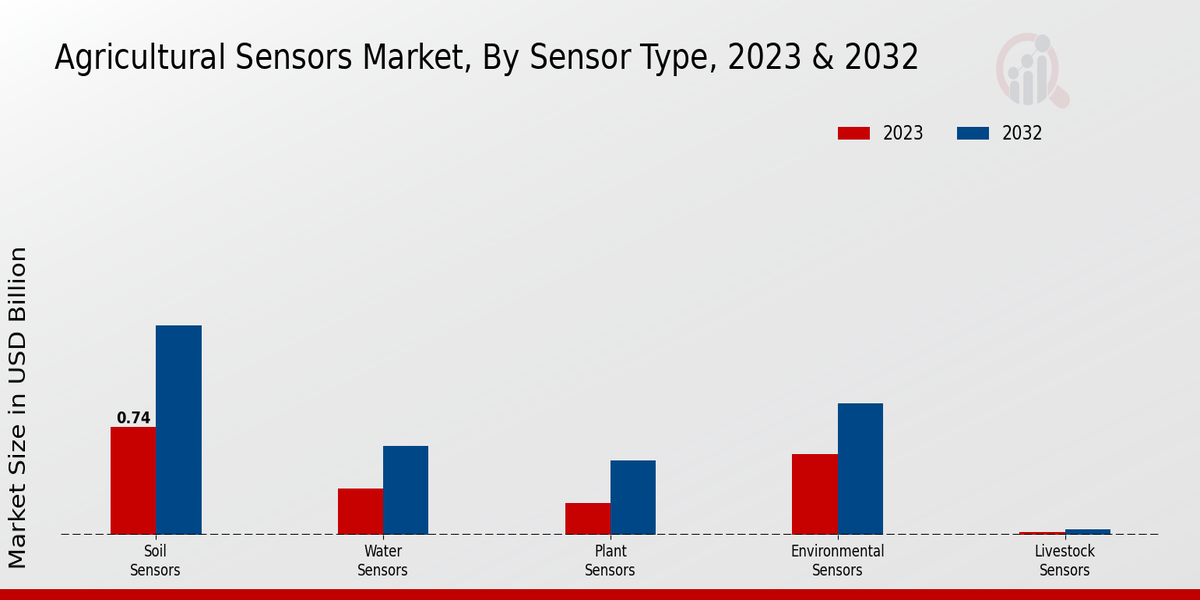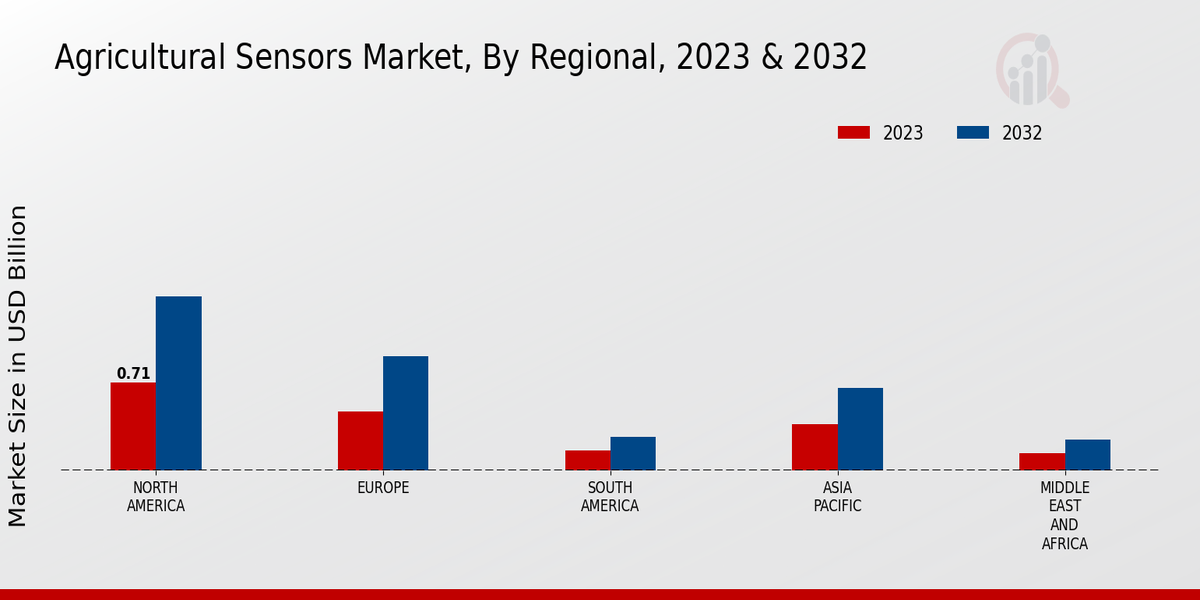Global Agricultural Sensors Market Overview
Agricultural Sensors Market Size was estimated at 4.18 (USD Billion) in 2022. The Agricultural Sensors Market Industry is expected to grow from 5.26 (USD Billion) in 2023 to 18.57 (USD Billion) by 2032. The Agricultural Sensors Market CAGR (growth rate) is expected to be around 15.30% during the forecast period (2024 - 2032).
Key Agricultural Sensors Market Trends Highlighted
The need to maximize crop yields and optimize resource utilization is driving precision farming trends. Precision farming also known as smart farming, has become popular because it helps in maximizing crop yields through optimal use of resources. The importance of these sensors is underscored by the growth in precision farming practices that are driven by the increased need to maximize crop yields and optimize the use of resources. Practically, wireless connectivity enables data transmission from farms to a central location for real-time monitoring and decision-making.
The penetration of AI systems into various industries has led to many changes in businesses, including agriculture.
Thus, AI-driven applications can provide accurate feedback on how specific crops fare under different environmental conditions. Today, there is also advancement of IoT (Internet of Things), among other technologies, using wireless connectivity enhancing the functionality of agricultural sensors. Sensors allow farmers to regulate irrigation levels, thereby avoiding wastage. In addition, they also help create a comprehensive picture of farm operation which involves observing every corner through intensive surveillance.
Smart agriculture refers to not only implementing new technologies but also includes aspects such as agricultural subsidies or policies put in place for food security reasons. The combination of digital technology like IoT (Internet of Things) and real-time data has transformed the way farmers work today. One example is placing internet-enabled sensors at different places in order to take measurements from the soil at different points, which gives an average result.
Furthermore, they enable farmers to perform regular checkups on their plants hence timely prevention or treatment against diseases. Besides reducing waste on farms, using IoT based devices reduces risk with increased production. Another factor behind this growth is increasing awareness about sustainability among people all over the world. As part of the sustainable agriculture movement, governments around the globe are investing heavily in initiatives aimed at modernizing farming techniques.

Source: Primary Research, Secondary Research, MRFR Database and Analyst Review
Agricultural Sensors Market Drivers
Increasing Demand for Precision Farming
Precision farming refers to a farming management concept that uses information technology to ensure that crops and soil receive exactly what they need for optimal health and productivity. This technology-driven approach allows farmers to save costs, increase yields, and reduce their impact on the environment. The role of agricultural sensors in precision farming is to provide real-time data on soil qualities, crop conditions, and weather.
By collecting this data, farmers can make informed decisions on irrigation and fertilization, as well as detect pests and diseases in the early stages. The process helps them improve the quality of crops and maximize yields. The use of precision farming continues to grow, which is among the key drivers of the Agricultural Sensors Market. The expansion of such practices increases the need for accurate and reliable sensors capable of taking and processing relevant information.
Government Initiatives and Support
Governments worldwide are recognizing the importance of agriculture and are implementing various initiatives to support the industry. These initiatives include funding for research and development, subsidies for farmers adopting new technologies, and policies that promote sustainable agriculture practices. The support from governments is a significant driver of the Agricultural Sensors Market, as it encourages farmers to invest in new technologies, including sensors, to improve their operations and increase productivity.
Technological Advancements
The constant improvement in the capabilities, as well as the reduced cost associated with the increased ease of manufacturing always more accurate, durable and connected sensors, is the main driver behind the growth of the Agricultural Sensors Market Industry.
Furthermore, additional technological developments are associated with the integration of these tools with other technologies, such as the sensors used as part of a drone payload, the IoT platform to support the data communication or the tools using the results to analyze it. As a result, these technologies are becoming more accessible and valuable to farmers, leading to both a growth in their adoption and an expansion of the size of the market.
Agricultural Sensors Market Segment Insights:
Agricultural Sensors Market Sensor Type Insights
This growth is because of the rising adoption of precision agriculture practices, the government’s drive for sustainability in farming, and technological advancements leading to improved sensor technology. By 2023, the sector of soil sensors accounted for the largest market share, totaling above 30% of the global revenue. This type of sensor provides data about the amount of moisture in the soil, its temperature, pH levels, and the presence of various nutrients. This allows farmers to take action to irrigate their crops better, in addition to fertilizing and managing other crop systems.
Another segment of water sensors plays an important part, and within this division, there are sensors for water usage and flow rate in addition to water quality sensors.
This provides a means for farmers to protect the environment through more sensible consumption, as well as to support their irrigation efforts, supplying water to crops that cannot flourish with lower-quality water. The remaining type of sensors – plants sensors – account for a far smaller market share, but these are rising in importance. They are used to take care of chlorophyll, leaf area, canopy cover, and the general health of the plants.
The fourth type – environmental sensors – also play a significant role, as these allow the farmers to examine climate and other conditions surrounding the plants. As for livestock sensors, these are even less important, but they are rising in popularity as well. The main factor driving the sector includes the increasing use of the Internet of Things and Wireless Sensor Networks. Overall, the sensors market is witnessing rapid growth that will continue in the coming years.

Source: Primary Research, Secondary Research, MRFR Database and Analyst Review
Agricultural Sensors Market Application Insights
The Agricultural Sensors Market is segmented by application into crop monitoring, livestock monitoring, water management, pest and disease control, and precision farming. Among these segments, crop monitoring is expected to hold the largest market share over the forecast period, owing to the increasing adoption of precision farming techniques and the need for real-time data on crop health and yield. Livestock monitoring is another significant segment, driven by the growing demand for automated livestock management systems and the need to improve animal welfare.
Water management is also expected to witness significant growth as farmers look for ways to optimize water usage and reduce costs. Pest and disease control is another important segment, driven by the need to protect crops from pests and diseases and reduce crop losses. Precision farming is a rapidly growing segment as farmers adopt technology to improve crop yields, reduce costs, and minimize environmental impact.
Agricultural Sensors Market Technology Insights
The Agricultural Sensors Market segmentation by Technology comprises Wireless Sensors, Wired Sensors, Remote Sensing, Data Analytics, and Artificial Intelligence. Wireless Sensors held the largest market share in 2023 due to their mobility and ease of deployment in remote areas. The Remote Sensing segment is projected to witness significant growth over the forecast period, owing to the increasing adoption of drones and satellite imagery for crop monitoring. Data Analytics and Artificial Intelligence are gaining traction in the market as they enable farmers to analyze large volumes of data and make informed decisions.
Agricultural Sensors Market End User Insights
The Agricultural Sensors Market Segmentation by End User reveals key insights into the diverse user base of these technologies. Farmers, agricultural cooperatives, agribusinesses, government agencies, and research institutions all play significant roles in driving market growth. Farmers, the primary users of agricultural sensors, leverage these devices to enhance crop yields, optimize resource utilization, and improve livestock management. In 2024, the farmer segment is projected to account for a substantial share of the Agricultural Sensors Market revenue, estimated to reach USD 1.2 billion.
This segment's growth is attributed to the rising adoption of precision farming techniques and government initiatives promoting sustainable agriculture practices. Agricultural cooperatives, serving as intermediaries between farmers and markets, also contribute to market growth by providing access to advanced sensor technologies and data analysis services. Market data indicates that the agricultural cooperatives segment is anticipated to witness a CAGR of 8.5% during the forecast period, driven by the increasing need for efficient supply chain management and traceability.
Agricultural Sensors Market Regional Insights
The regional segmentation of the Agricultural Sensors Market offers valuable insights into the market's geographical distribution and growth dynamics. North America is expected to dominate the market with a revenue of USD 0.92 billion in 2024, primarily driven by the region's extensive adoption of precision agriculture and government initiatives supporting sustainable farming practices. Europe follows closely with a revenue of USD 0.61 billion, driven by the region's stringent regulations on food safety and environmental protection.
The Asia-Pacific (APAC) region is projected to witness significant growth, reaching a revenue of USD 0.48 billion in 2024, attributed to the increasing demand for food production in emerging economies like China and India. South America and the Middle East and Africa (MEA) regions are expected to contribute a revenue of USD 0.21 billion and USD 0.18 billion, respectively in 2024, with growth driven by rising awareness of agricultural technology and increasing investments in smart farming solutions.

Source: Primary Research, Secondary Research, MRFR Database and Analyst Review
Agricultural Sensors Market Key Players And Competitive Insights:
Major players in the Agricultural Sensors Market are heavily investing in research and development to introduce innovative sensor solutions that cater to evolving customer needs. Leading Agricultural Sensors Market players are focusing on strategic partnerships and collaborations to enhance their product portfolio and expand their market reach. The Agricultural Sensors Market industry is characterized by a high level of competition, with several established players and emerging startups vying for market share. These players are constantly innovating and developing new sensors and solutions to meet the growing demand for precision agriculture.
John Deere, a leading Agricultural Sensors Market player, is focused on providing comprehensive sensor-based solutions for farmers. The company offers a range of advanced sensors that monitor soil moisture, crop health, and yield, enabling farmers to make informed decisions about irrigation, fertilization, and other crop management practices. John Deere has also invested in telematics and data analytics to provide farmers with real-time insights into their operations. This helps farmers optimize their production processes, reduce costs, and improve profitability. Another key competitor in the Agricultural Sensors Market is Trimble.
The company offers a wide range of sensor solutions, including GPS receivers, soil sensors, and yield monitors. Trimble's sensors are designed to provide farmers with accurate and timely data on their operations, helping them to improve precision and efficiency. The company has also developed a suite of software and data analytics tools that help farmers analyze their data and make informed decisions. Trimble's commitment to innovation and customer support has made it a trusted partner for farmers worldwide.
Key Companies in the Agricultural Sensors Market Include:
- AGCO
- Raven Industries
- Topcon Agriculture
- John Deere
- Arable
- Sencrop
- AgriSens
- Trimble
- Invensense
- CNH Industrial
- Omega Engineering
- Yokogawa Electric Corporation
- Deere Company
- Ag Leader Technology
- FarmSense
Agricultural Sensors Industry Developments
The agricultural sensors market is projected to reach USD 3.5 billion by 2032, exhibiting a CAGR of 7.3% during the forecast period (2024-2032). The growing demand for precision farming, increasing government initiatives, and rising awareness about the benefits of agricultural sensors drive market growth. Recent advancements in sensor technology, such as the integration of IoT and AI, are further fueling market expansion. Key industry developments include strategic partnerships, product launches, and acquisitions.
For instance, in January 2023, Deere Company acquired Bear Flag Robotics to strengthen its autonomous agricultural solutions portfolio. Similarly, in March 2023, Raven Industries introduced the latest version of its Slingshot platform, offering enhanced data management and analytics capabilities for farmers.
Agricultural Sensors Market Segmentation Insights
-
Agricultural Sensors Market Sensor Type Outlook
-
Agricultural Sensors Market Application Outlook
-
Agricultural Sensors Market Technology Outlook
-
Agricultural Sensors Market End User Outlook
- Agricultural Cooperatives
-
Agricultural Sensors Market Regional Outlook
| Report Attribute/Metric |
Details |
| Market Size 2023 |
4.18 (USD Billion) |
| Market Size 2024 |
5.26 (USD Billion) |
| Market Size 2032 |
18.57(USD Billion) |
| Compound Annual Growth Rate (CAGR) |
15.30% (2024 - 2032) |
| Report Coverage |
Revenue Forecast, Competitive Landscape, Growth Factors, and Trends |
| Base Year |
2023 |
| Market Forecast Period |
2024 - 2032 |
| Historical Data |
2019 - 2023 |
| Market Forecast Units |
USD Billion |
| Key Companies Profiled |
AGCO, Raven Industries, Topcon Agriculture, John Deere, Arable, Sencrop, AgriSens, Trimble, Invensense, CNH Industrial, Omega Engineering, Yokogawa Electric Corporation, Deere Company, Ag Leader Technology, FarmSense |
| Segments Covered |
Sensor Type, Application, Technology, End User, Regional |
| Key Market Opportunities |
Precision Farming Automation.DataDriven Crop Management.Smart Irrigation Optimization.Livestock Monitoring Advancements.IoT Integration for Realtime Insights. |
| Key Market Dynamics |
Increasing adoption of precision farming techniques.Growing demand for food safety and traceability.Government initiatives supporting sustainable agriculture.Advancements in sensor technologies and connectivity.Rising labor costs in agricultural operations. |
| Countries Covered |
North America, Europe, APAC, South America, MEA |
Frequently Asked Questions (FAQ):
The Agricultural Sensors Market is expected to reach USD 18.57 billion by 2032, growing at a CAGR of 15.30 % from 2024 to 2032. The market growth is attributed to the increasing demand for precision farming, government initiatives to promote sustainable agriculture, and the rising adoption of IoT technologies in the agricultural sector.
North America and Europe are expected to dominate the Agricultural Sensors Market. The high adoption of precision farming techniques, government support for smart agriculture, and the presence of major agricultural equipment manufacturers in these regions contribute to their dominance.
Agricultural Sensors find applications in various areas, including crop monitoring, soil moisture sensing, livestock monitoring, irrigation management, and weather monitoring. These sensors provide real-time data on crop health, soil conditions, and environmental factors, enabling farmers to make informed decisions to optimize crop yield and reduce environmental impact.
Key players in the Agricultural Sensors Market include Trimble, Deere Company, AGCO Corporation, Raven Industries, Topcon Positioning Systems, and Ag Leader Technology. These companies offer a range of Agricultural Sensors for various applications, such as soil moisture sensors, crop sensors, and weather stations.
The increasing adoption of IoT and wireless technologies, the growing demand for precision farming, and the rising awareness of sustainable agriculture practices are some of the key trends influencing the Agricultural Sensors Market. These trends are expected to continue to drive market growth in the coming years.
The high cost of Agricultural Sensors, the lack of interoperability between different sensors and platforms, and the need for skilled labor to interpret and utilize sensor data are some of the major challenges faced by the Agricultural Sensors Market.
The COVID-19 pandemic had a mixed impact on the Agricultural Sensors Market. While some segments experienced a decline due to supply chain disruptions and labor shortages, other segments, such as remote monitoring and data analytics, witnessed increased demand as farmers sought ways to optimize operations and reduce labor dependence.
The future growth of the Agricultural Sensors Market is expected to be driven by the increasing adoption of precision farming, government initiatives to promote sustainable agriculture, and the growing demand for food security. Advancements in sensor technologies, such as miniaturization, low power consumption, and wireless connectivity, are also expected to contribute to market growth.
Key opportunities for market participants include developing cost-effective and interoperable Agricultural Sensors, offering integrated solutions that combine sensors with data analytics and decision support tools, and expanding into emerging markets with high growth potential.
Market participants are advised to focus on innovation and product differentiation, strengthen partnerships with technology providers and agricultural stakeholders, and invest in research and development to stay competitive in the evolving landscape of the Agricultural Sensors Market.

















